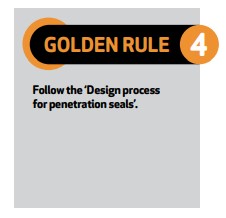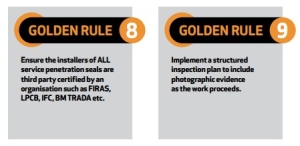
This article is based on the panel discussion held at London Build on the 16 November 2022.
The panel members were:
- Mandy Youssef: Senior Fire Engineer, BB7 – since joining BB7, Mandy has worked on a wide range of UK projects, ranging from complex artistic residential developments, shopping centres, hospitals, and transport infrastructure.
- Joshua Raper: Director, Fire Shield – he was appointed as Director of Fire Shield in January 2021 after spending the first six years working with clients to develop schemes at an early stage to ensure their passive fire protection expectations were met.
- Alec Purdie: Technical Coordinator, Quelfire – he provides technical assistance for the passive fire protection industry and helps architects, design teams and firestoppers find the best tested solution for their application.
- Moderator: Craig Wells, Sales Director, Quelfire – supports various stakeholders in construction projects, he is a keen advocate of educating the industry about firestopping requirements.
In the Firestopping of Service Penetrations: Best Practice in Design and Installation guide, a collaboration between trade associations, it defines nine golden rules to follow. This discussion will answer questions surrounding these and demonstrate how by following them, ultimate building compliance can be achieved.
It is important to note that out of the nine golden rules, seven relate to the design of the building, which shows where the emphasis needs to be. If you get the design right, a compliant installation will be easier to achieve.

1a) How are fire rating requirements in a fire strategy determined?
A fire strategy offers a transparent set of measures including fire precautions, management of fire safety, and fire protection. It determines the fire rating of the compartment walls and floors, which in turn determine the fire rating of firestopping solutions to be used.
When a fire engineer is selected to be part of the design team, they become responsible for creating a fire strategy that complies with building regulations. B3 internal fire spread states that ‘a building shall be designed and constructed so that, in the event of a fire, its stability will be maintained for a reasonable period.’ Therefore, Mandy highlighted that the fire strategy will determine how the fire rating is applied and whether it is achieved from both sides or the underside of walls/ floors.
It is also essential that designers, contractors, and all those involved in the project understand the fire strategy document/ drawings. Even though fire ratings are usually determined before the firestopper’s engagement, Josh understands that the fire ratings are affected by the type of building, the intended use, height, and persons at risk.
1b) Why is early engagement important?
Early engagement in firestopping is crucial as it allows all key parties to review the current information and spot any fundamental issues early in the project. Josh emphasised that it ensures the team has enough time to discuss lessons learnt on previous projects, while discussing new tested details, ensuring they are constructing better, and safer buildings.
He also said that “if well-documented, it gives the key stakeholders assurances that the relevant persons have discussed passive fire protection at a high level, but also at an early enough stage, to ensure it is built into the fabric of the building.”
Similarly, Mandy agreed that early engagement is key to establishing areas of improvement and design constraints that could occur. She said, “It eases work at the installation stage by utilising the support from the manufacturer to select the appropriate tested solutions.” Mandy also raised that training on early engagement has been beneficial across the board in achieving quality applications.
1c) How early can early engagement take place?
Service penetration seals must be considered throughout the M&E design phase so that the correct and compliant penetration seals can be identified. Although the M&E services are not known at this stage, Mandy suggests, “At least keep track of the details and engage with the firestopping contractor and manufacturer”.
Supporting this, Josh and his team regularly engage with the architect to ensure that they understand the manufacturer’s test data. He said, “It’s never too early, the sooner the better as it is an evolving industry.”
When it comes to early engagement in firestopping, often a cultural change is needed. Craig highlighted that it is vital to pay attention to the details early in the design stage to avoid firestopping being left till the end. And, of course, ensuring that all parties are communicating with each other to make sure the proposals are compliant.

A suggested process would include identifying a project’s wants and needs, then engaging early with a firestopping solution provider to identify suitable tested solutions. However, Craig stressed that at this stage it is important to have an open mind as there may not be a tested solution for the suggested proposal.
Once the tested details have been coordinated and verified, the openings, penetrations, and spacings of the services will be designed to suit the tested solutions, and the proposals will be sent out to the relevant parties for their approval. When approved, the project will move into the build stage.
2a) What influences the choice of services and insulations?
In the context of firestopping, M&E services create the problem that service penetration sealing solves. Therefore, the choice of materials, such as plastic/ copper, impact the tested solutions to be used.
Different service types react differently in a fire scenario. Alec emphasised that design teams must remain flexible when choosing their service types as their first choice may not be suitable for the overall reaction to fire. He said, “For example, a copper pipe is non-combustible but what many people don’t consider is that copper is an extremely good conductor of heat. Therefore, an uninsulated copper pipe will unlikely achieve a high insulation fire rating, making the seal non-compliant.”

3a) Who should be the suitably qualified person that reviews the proposals?
Alec and Mandy believe that predominantly it is up to all the stakeholders, including M&E contractors to fire engineers, to do their due diligence, ensuring that their proposals meet the requirements of the project. Josh further added that all stakeholders must take responsibility because building control “may not have the knowledge or competence to approve these details”.
The design team would have to obtain the fire test information of the supporting construction and the fire stop seals to be used. However, Alec highlighted other factors such as electrical and gas regulations as these could also have an impact on the design. Another factor is the practicality of the installation. “A design can look good on paper, but can the installer install it?” – he asked. Consequently, to ensure compliance, all stakeholders must be engaged as early as possible at the design stage and work together to agree on the proposal.
All panellists agreed that inspections should be carried out by key stakeholders. They should take place at critical stages of construction as installations often cannot be inspected once the fabric of the building is installed, for example, a cavity barrier to the façade.
3b) How important is the documentation for future reference?
Regulation 38 requires that ‘the person carrying out the work shall give fire safety information to the responsible person.’ This is commonly known as the Golden Thread of Information, which guarantees there are records of compliance and competence during and on completion of construction. Josh said, “Having the Golden Thread will mean that those people responsible will have accessible, reliable, up-to-date, and accurate information otherwise it makes it difficult to manage a building safely.”
Mandy highlighted that it is also important for proof of traceability when reviewing work to learn from the outcomes. Therefore, it’s imperative that the contractor can provide such information or a process to meet these requirements.

4a) Does the use of third-party accredited installers provide extra confidence?
By using accredited, competent contractors and products, developers can ensure work undertaken is within industry best practices. Mandy said, “It creates a transparent paper trail and offers trust to the client. Also, carrying out regular spot checks ensure quality remains consistent and it acts as a guarantee of standards.”
However, it is crucial not to become complacent. Alec emphasised that parties still need to carry out checks during the build to ensure the application is being installed correctly, to the agreed design. He said, “I use an acronym of G.O.A.L (Go Out And Look) to site managers to ensure that at all stages of the build dryliners, M&E and firestoppers continue to check and make sure that everyone is compliant.”
4b) To what extent can accredited installers be used?
Alec believes that accredited installers can be used as much as possible. Designs and applications can be complex as there is a lot of detail and coordination required. He said, “However, there are some products that might not always require a fully accredited firestopper. For example, the Cast in Fire Collar, a readymade device that is positioned before the concrete is poured, is installed at very early stages of construction.” He highlighted that this is where dedicated manufacturer product installation training and the use of sample boards can be valuable to ensure the product is installed correctly.
Key takeaways:
- Passive fire protection is complex – get educated.
- You need to design using tested and certified solutions.
- Engage early and collaborate with all parties – follow the process.
- Stick to the plan – use sample boards and demo walls.
- Use a third-party accredited installer.
- Regular inspections.
- Photographic record & digital record keeping – Golden Thread!
References:
- Firestopping of Service Penetrations: Best Practice in Design and Installation, produced collaboratively by the Association for Specialist Fire Protection (ASFP), Building Engineering Services Association (BESA), Building Services Research and Information Association (BSRIA), Finishes and Interiors Sector (FIS) and the Gypsum Products Development Association (GPDA).

This article was written by Rebecca Croton
Content Marketing Executive
Learn More About Rebecca Croton